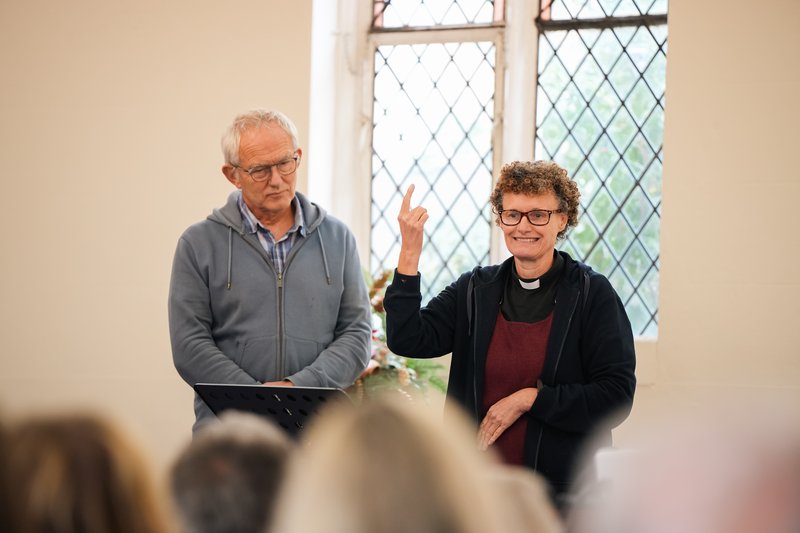As autumn leaves begin to fall, the Deaf Christian community in the East Anglia Methodist District is preparing for a special celebration. At the end of September, Deaf Christians from Norwich joined with Anglican Deaf churches from Cambridge and Ipswich gathered for a joyous harvest festival. With a turnout of 40-50 people, this event was a vibrant occasion of worship, fellowship and thanksgiving.
This harvest gathering exemplifies the strong sense of community among Deaf Christians in the region. However, it also highlights the ongoing need for greater inclusion and support from mainstream churches.
The Norwich Deaf Church, which meets at Chantry Hall on the first Saturday of each month, has become a vital spiritual home for many. Revd Anne Richardson has extensive experience working with the Deaf community as a BSL interpreter and starting church events that cater to Deaf communities within the Connexion.
When Anne arrived in the East Anglia District, she noticed that, even though there was a Deaf community, the church was not catering to their needs. So, she started Sign the Cross.
Anne describes their typical gatherings, "We get about 15-20 people, mostly Deaf people, with a few hearing people learning to sign, or with Deaf family. It’s a mixed group and it’s a nice atmosphere. It's informal, we're developing worship in a style that is more culturally appropriate."

Baptist Minister, Rev Sue Whalley with her husband Bryan
An invisible congregation
This dedicated space for Deaf worship is crucial, as mainstream church services often present significant barriers for D/deaf individuals. The challenges faced by D/deaf individuals in accessing religious services are numerous and often overlooked.
Traditional church services rely heavily on spoken language, leaving D/deaf attendees feeling isolated and excluded. Anne says, "Church and worship are dominated by the English language and following English structure, whereas BSL has got its structure and grammar. Although everyone's welcome, we want to create a Deaf space where BSL has priority.”
Even when churches attempt to be more inclusive, the results can be mixed as Anne explains, “Sometimes people who cannot sign very well are asked to 'look after' the D/deaf people. Can you imagine going to church and not being able to communicate? You might think they're trying their best to sign, they are trying, but would you want to go every week?"
The need for greater support and understanding from mainstream churches is evident. For Anne, “The Deaf community is often ignored, within and without the church. Except for some events, there is rarely an interpreter. How can we then cater to the Deaf community? How do we make this accessible for them?"
This lack of consideration extends beyond just providing interpreters. Many aspects of church life that hearing individuals take for granted can be challenging for D/deaf people. For instance, the language used in hymns and liturgy can be complex and difficult to understand.
The barriers extend beyond Sunday services. Educational opportunities within the church, such as becoming a local preacher, are often inaccessible to Deaf individuals. "It's inaccessible for Deaf people unless you've got a high level of English," says Anne.

Revd Anne Richardson (picture on the right)
Working towards more inclusion
However, there are signs of progress. The development of a British Sign Language GCSE, championed by the National Deaf Children’s Society and young Deaf advocates like Daniel Jillings – who campaigned on the issue since he was 12 years old – offers hope for greater awareness and inclusion in the future. Daniel has been part of the Deaf Church for many years. He was recently interviewed as part of the District's EDI series.
The path forward requires a multifaceted approach. Churches need to consider providing interpreters, using visual aids effectively and educating their congregations about Deaf culture and basic sign language.
As Anne envisions, "My hope is for every district, to have a few accessible churches for Deaf people, where there's an interpreter, where all the special events have interpreters and where many congregation members know a few signs."
In the East Anglia District, Anne wants to go a step further and offer more help to the Deaf community. She is still praying and thinking of how to make it happen, but the social justice project would offer support for Deaf people outside the church alongside mental health support.
Ultimately, the goal is to create truly inclusive faith communities where Deaf individuals are not just accommodated, but fully integrated and valued. As the harvest festival demonstrates, when given the opportunity, Deaf Christians eagerly come together to worship and fellowship. The challenge now is for the wider church to recognise this invisible congregation and take meaningful steps towards genuine inclusion.
Deaf or deaf?
D – Deaf people who identify as Deaf, culturally and linguistically, using BSL as a preferred language. This is the group of people Sign the Cross serve.
There are, of course, Deaf people who identify with the community but prefer to use English themselves.
d – deaf people – those who have hearing loss, but don't identify with the Deaf community. Mostly deaf people are those who were born hearing and, at some point, have lost some or all of their hearing. They tend to use English and manage with apps and subtitles etc, rather than learning and using BSL. Most elderly people who have lost hearing due to age will fit into this group.
Of course – there will be people who don't like differentiating D/deaf – but it is useful to help people understand the difference and why for this group, we have to provide interpreters to enable any sort of equity.

